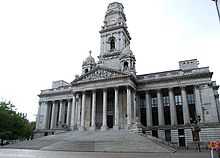Portsmouth Guildhall
Coordinates: 50°47′51.8″N 1°5′34.4″W / 50.797722°N 1.092889°W

Portsmouth Guildhall is the biggest events venue in the Hampshire city of Portsmouth in England.
History
The building, completed in 1890,[1] was designed in the neo-classical style by architect William Hill, who was responsible for the design of Bolton Town Hall. Local architect Charles Bevis, in partnership with Hill, directed the construction. Hill died before the building was completed and Bevis added to the design. The building was originally the town hall, but on 21 April 1926 Portsmouth was raised to the status of a city and the town hall was renamed the Guildhall. The Guildhall has a capacity of up to 2000 [2] It is in the city centre close to the Portsmouth and Southsea railway station.
On 10 January 1941, during the Second World War, it was hit by incendiary bombs and gutted. The interior and roof were destroyed, with just the outer walls and tower remaining, albeit fire-damaged. It was rebuilt after the war at a cost of £1.5 million, using war compensation funds, and on 8 June 1959 Her Majesty the Queen performed the re-opening ceremony. The interior was altered from the original and the external style is missing much of its detail, especially the dome above the clock and the finials atop the balustrades around the roof.
There are five bells in its bell tower known as the Pompey Chimes. The biggest bell is named after Queen Victoria and is inscribed with her name.[3] The remaining four were named by public poll and Nelson, Victory and John Pounds[4] The official naming was stalled due to the popularity of the vote for Harry Redknapp,[5] the former Portsmouth Football Club manager who departed the club shortly before voting commenced. Foul play was suspected by the council who ran the vote and the bells have remained unnamed.[6]
The Pompey Chimes fell silent in 2003 when the bell tower was found to be in need of restoration from the corrosive nature of salt in the air.[7] The work was carried out by Smith of Derby Group, the restoration project finishing in time for Queen Elizabeth's visit to Portsmouth in 2009 to mark the 65th anniversary of the D-Day landings.[8]
References

- ↑ Portsmouth Guide website: Portsmouth Guildhall History
- ↑ Portsmouth Guildhall official website accessed 8 February 2011
- ↑ Portsmouth News website: Pompey Chimes back where they belong!
- ↑ BBC website: The Queen's visit to Portsmouth in 2009
- ↑ Portsmouth News website: Bell Name Poll Chimes a Low Note with Council
- ↑ Portsmouth News website: Chimes Stay Unnamed Because Harry's In The Frame
- ↑ Smith of Derby website: Portsmouth Guildhall Bell Tower case study
- ↑ BBC website: The Queen's visit to Portsmouth in 2009
External links
| Wikimedia Commons has media related to Portsmouth Guildhall. |